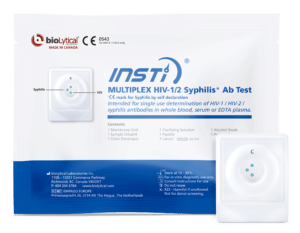- INSTI HIV Self Test, manufactured by Vancouver-based company bioLytical, is part of the HIV Self-testing Canada study.
- The first HIV self-testing kits were provided from the Women’s Health in Women’s Hands clinic located in Toronto.
- HIV self-testing is seen as a way of reaching the undiagnosed, helping to reach UNAIDS’ targets on ending HIV.
With this month’s headlines filled with exciting news surrounding HIV self-testing in Canada, we’re sharing the history behind self-testing. Lauded as a critical tool for reaching people who may not otherwise access testing, its use has grown in recent years. Several ground-breaking programs in Europe and Africa have focused on providing convenient, at-home testing with INSTI. But where did INSTI HIV Self Test come from, and how is it being used right now?
INSTI HIV Test
INSTI HIV Self Test is based on the INSTI HIV-1 / HIV-2 Antibody Test, which was developed in Richmond, BC by bioLytical Laboratories. bioLytical first introduced it as a point-of-care test to Canada and the European Union in 2006, followed by the US in 2010. The testing community soon recognized INSTI as a useful solution, featuring novel technology which provides instant results from a one-minute procedure. On the other hand, results from laboratory testing, the most common form in Canada, can take several days to reach the patient. It may even take longer for those living in remote communities. More than ten years on from its launch, INSTI has been used millions of times to screen for HIV. INSTI is found in a variety of testing scenarios, from medical settings like clinics to mobile testing in the community.
The Origins of Self-testing
The scientists behind INSTI began to consider adapting this technology for an at-home test in 2012 as the HIV/AIDS research community sought new options for reaching key populations. This includes people living in Sub-Saharan Africa, the region that is most affected by HIV. Ryan Bennett, bioLytical’s Vice President, Global Business Solutions explains, “Part of the reasoning behind developing the INSTI HIV Self Test was to bring a much-needed blood-based self-test to the market. HIV is a blood-borne virus so testing for antibodies in the blood is more accurate than testing in other ways like oral fluid. By developing the INSTI HIV Self Test, we have given people a more accurate and easier to use option when it comes to at-home testing.”
bioLytical’s self-test gained CE Mark in 2016. This was the same year that the World Health Organization (WHO) endorsed HIV Self Testing as “an additional approach to HIV testing services.” WHO later awarded Prequalification status to the self-test, allowing it to be procured by agencies like PEPFAR and the United Nations. Since then, it has become part of numerous programs designed to help countries in Sub-Saharan Africa to reach the first of the UN’s 90-90-90 targets. This target aims to ensure that 90% of all people living with HIV know their status. One of these programs is the HIV Self-Testing Africa (STAR) Initiative, the world’s largest ongoing demonstration of HIV self-testing to date. It aims to distribute 4.7 million HIV self-testing kits in countries including Malawi, Zambia, and South Africa.
Self-testing in Canada
HIV remains a concerning health issue in Canada, and it is on the rise. 14% of people with HIV in Canada are undiagnosed, which represents 9,090 individuals with HIV who are not aware of their status.
On August 8, the first Canadian study to evaluate HIV self-testing in Canada was announced, with INSTI as the test of choice. bioLytical’s Chief Technical Officer explains, “When we initially started developing the self-test, we weren’t sure if it would ever come to Canada. It had always been thought of as a tool for testing in regions like Sub-Saharan Africa, where there was a huge gap between people living with HIV and those that knew their status.” He adds, “The statistics show that HIV self-testing can be a valuable option to aid Canadian communities in reaching the undiagnosed, linking those people to life-saving care and support. As a Canadian company, we are proud to have this chance to bring another tool to our country’s fight against HIV.”
INSTI HIV Self Test Study
The study, funded by The CIHR Centre for REACH 3.0 and the Canadian Foundation for AIDS Research (CANFAR), launched today at the Women’s Health in Women’s Hands clinic located in Toronto. Running for 16 weeks across five cities including Victoria, it includes 1,000 participants from key priority populations. These focus populations include communities that are disproportionately affected by HIV including gay, bisexual, men who have sex with men, people of African and Caribbean background. It also includes Indigenous peoples (First Nations, Metis and Inuit), people who use drugs, and at-risk youth and women. If the study is successful, the results will be used as the cornerstone of a licence application for the INSTI HIV Self Test to Health Canada. If this application is approved, then the test can become available in Canada for discreet, at-home HIV testing.



